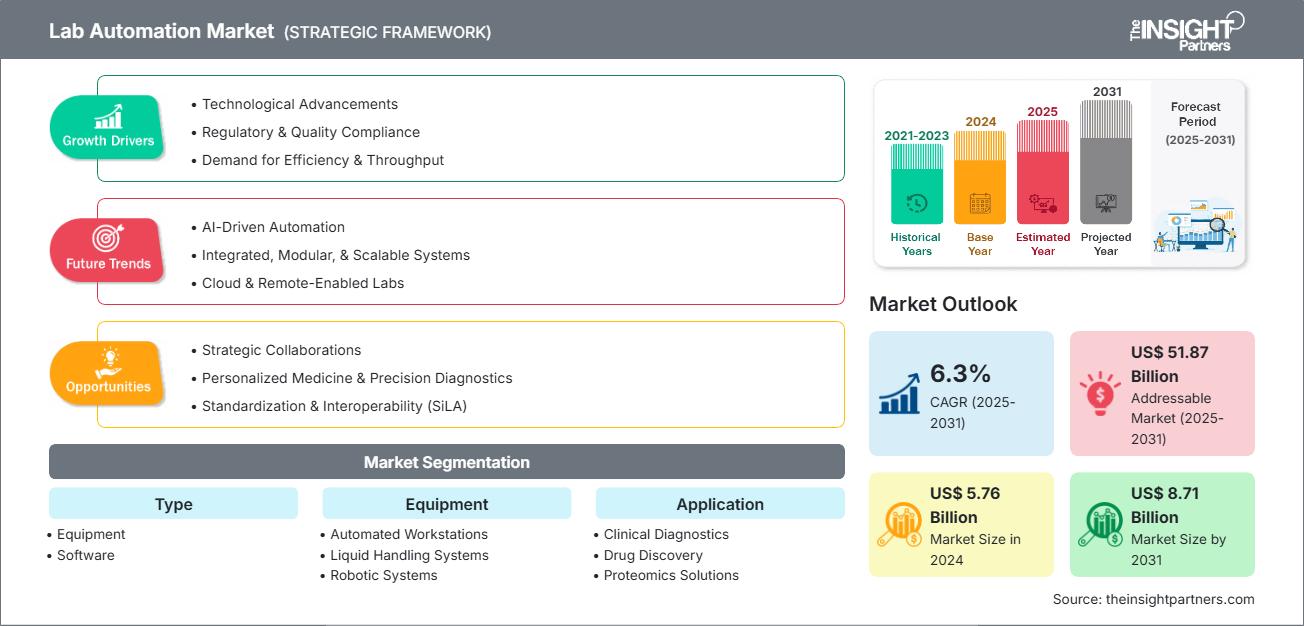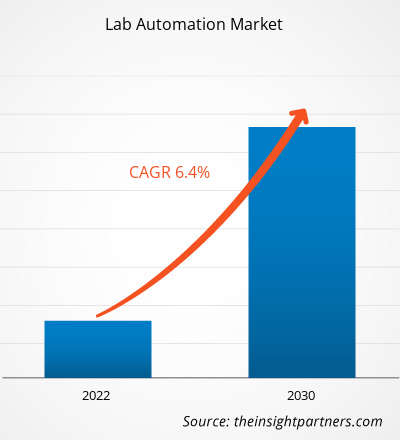[調査レポート] ラボオートメーション市場規模は、2022年の51億6,631万米ドルから2030年には84億8,327万米ドルに拡大し、2022年から2030年にかけて6.4%のCAGRを記録すると予想されています。
ラボオートメーション市場の洞察とアナリストの見解:
ラボにオートメーションを統合して、新しい強化されたラボプロセスを可能にすることをラボオートメーションといいます。ラボオートメーション技術の最もよく知られた用途は、ラボロボットです。さらに、ラボオートメーションには、ラボでの研究の有効性を可能にし、加速し、改善するために使用される自動化されたラボ機器、デバイス、ソフトウェアアルゴリズム、および方法論が広範囲に及んでいます。ラボオートメーション市場分析に基づくと、ラボオートメーション市場を牽引する主な要因は、ラボオートメーションによって提供されるアプリケーションと利点の増加と、成長する製薬業界です。しかし、高額な設備投資によるラボオートメーションの導入の遅れが、ラボオートメーション市場の成長を阻害しています。
成長ドライバーと抑制要因:
バイオテクノロジー、医薬品、臨床診断、学術研究、環境試験などは、ラボオートメーションの増加が見られた主要産業です。実験室手順における効率、精度、スループットの向上が求められていることから、ラボオートメーションの需要が高まっています。オートメーション技術の活用は、科学研究開発の生産性と品質に大きな影響を与えるさまざまなメリットをもたらします。主な利点と用途としては、ハイスループットスクリーニング、サンプルの準備と処理、データ管理と統合、ワークフローの最適化、柔軟性とカスタマイズ、品質管理と保証、リソースの最適化、長期的なコスト削減、危険な化学物質や生物学的材料の手作業による取り扱いの削減、ラボのキャパシティと機能の拡大などが挙げられます。このように、ラボオートメーションはますます有利になっており、さまざまな産業における科学研究開発をどのように変革するかが注目されています。技術の発展に伴い、ラボの自動化が進み、科学的な取り組みにおける効率性と革新性が高まると予想されています。
しかしながら、バイオテクノロジー業界や製薬業界をはじめとする多くの企業は、高額な設備投資のためにラボの自動化導入において大きな問題を抱えています。ラボの自動化は、効率性、精度、スループットの向上など、様々なメリットをもたらしますが、自動化システム導入の初期コストは、企業によっては負担が大きすぎる場合があります。ラボの自動化に必要な高額な設備投資には、機器コスト、インフラ要件、統合とカスタマイズ、保守とサポート、高度な専門知識の要件、技術陳腐化のリスクなど、様々な要因が影響しています。例えば、Retisoft Inc.によると、小型の自動ロボットシステムの価格帯は10万~30万米ドルです。しかし、より複雑で大規模なラボ自動化システムは、100万米ドルを超える場合も少なくありません。このように、ラボの自動化に必要な高額な設備投資は、多くのバイオテクノロジー企業や製薬企業、特に資金が限られている小規模企業や新興企業にとって、ラボの自動化導入の妨げとなる可能性があります。したがって、上記の要因は、世界的なラボ自動化市場の成長を妨げる可能性が高い。
要件に合わせてレポートをカスタマイズ
レポートの一部、国レベルの分析、Excelデータパックなどを含め、スタートアップ&大学向けに特別オファーや割引もご利用いただけます(無償)
ラボ自動化市場: 戦略的洞察

-
このレポートの主要な市場動向を入手してください。この無料サンプルには、市場動向から見積もりや予測に至るまでのデータ分析が含まれます。
レポートのセグメンテーションと範囲:
世界のラボオートメーション市場レポートは、製品、アプリケーション、エンドユーザーに基づいてセグメント化されています。製品に基づいて、ラボオートメーション市場は機器とソフトウェアに分かれています。機器に基づいて、市場は自動化ワークステーション、マイクロプレートリーダー、ロボットシステム、既製の自動化作業セル、自動保管および検索システム(ASRS)、その他に細分化されています。ソフトウェアに基づいて、市場は実験実行システム(LES)、実験情報管理システム(LIMS)、電子実験ノート(ELN)、および科学データ管理システム(SDMS)に細分化されています。アプリケーションに基づいて、ラボオートメーション市場は臨床診断、創薬、プロテオミクスソリューション、ゲノミクスソリューションなどに細分化されています。エンドユーザーに基づいて、ラボオートメーション市場は製薬会社、病院および診断センター、教育研究機関、および契約研究機関に分類されています。ラボオートメーション市場レポートは、地理に基づいて、北米(米国、カナダ、メキシコ)、ヨーロッパ(ドイツ、フランス、イタリア、英国、ロシア、その他ヨーロッパ)、アジア太平洋(オーストラリア、中国、日本、インド、韓国、その他アジア太平洋)、中東およびアフリカ(南アフリカ、サウジアラビア、UAE、その他中東およびアフリカ)、南米および中米(ブラジル、アルゼンチン、その他南米および中米)に分割されています。
セグメント分析:
製品に基づいて、ラボオートメーション市場は機器とソフトウェアに分かれています。機器セグメントは2022年にラボオートメーション市場で大きなシェアを占めました。ただし、ラボオートメーション市場予測に基づくと、ソフトウェアセグメントは2022~2030年の間に高いCAGRを記録すると予想されます。
機器に基づいて、ラボオートメーション市場は、自動ワークステーション、液体処理システム、ロボットシステム、マイクロプレートリーダー、自動保管および検索システム(ASRS)、その他に細分化されています。
アプリケーションに基づいて、ラボオートメーション市場は、臨床診断、創薬、プロテオミクスソリューション、ゲノミクスソリューション、その他に分類されます。創薬セグメントは、2022年にラボオートメーション市場規模で最大のシェアを占めました。ただし、ラボオートメーション市場の予測に基づくと、臨床診断セグメントは2022年から2030年にかけて最高のCAGRを記録すると予想されます。
エンドユーザーに基づいて、ラボオートメーション市場は、製薬会社、病院および診断センター、教育および研究機関、および契約研究機関に分割されています。2022年には、製薬会社セグメントがラボオートメーション市場規模で最大のシェアを占めました。ただし、ラボ自動化市場予測に基づくと、病院および診断センターセグメントは、2022~2030年に最高のCAGRを記録すると予想されています。
地域分析:
地理に基づいて、世界のラボ自動化市場は、北米、ヨーロッパ、アジア太平洋、南米および中米、中東およびアフリカの5つの主要地域に分割されています。
2022年には、北米が世界のラボ自動化市場規模で最大のシェアを占めました。医療インフラの発達と米国全土におけるヘルスケアサービスへの支出の増加が、この国のラボ自動化市場を牽引しています。臨床試験、医薬品開発、生物医学研究におけるラボ自動化の使用は、ラボ自動化市場の成長に大きな影響を与えています。これらのシステムは、ほとんど監視や指示なしに長期間稼働することもできるため、研究者は主要な作業に集中でき、反復的な作業に費やす時間を減らすことができます。さらに、米国メディケア・アンド・ヘルスセンター(C&M)は、ラボ自動化の市場規模を2022年から2030年にかけて拡大する見込みです。米国のメディケイドサービス(CMS)は、臨床検査改善法(CLIA)に基づいてヒト検査研究に関連する基準を採用しており、これによりラボ自動化市場の成長が促進されました。
ラボ自動化
ラボ自動化市場の地域別分析The Insight Partnersのアナリストは、予測期間を通じてラボ自動化市場に影響を与える地域的な動向と要因を詳細に解説しています。このセクションでは、北米、ヨーロッパ、アジア太平洋、中東・アフリカ、中南米におけるラボ自動化市場のセグメントと地域についても解説しています。
ラボオートメーション市場レポートの範囲
| レポート属性 | 詳細 |
|---|---|
| の市場規模 2024 | US$ 5.76 Billion |
| 市場規模別 2031 | US$ 8.71 Billion |
| 世界的なCAGR (2025 - 2031) | 6.3% |
| 過去データ | 2021-2023 |
| 予測期間 | 2025-2031 |
| 対象セグメント |
By タイプ
|
| 対象地域と国 |
北米
|
| 市場リーダーと主要企業の概要 |
|
ラボ自動化市場のプレーヤー密度:ビジネスダイナミクスへの影響を理解する
ラボオートメーション市場は、消費者の嗜好の変化、技術の進歩、製品メリットへの認知度の高まりといった要因によるエンドユーザーの需要増加に牽引され、急速に成長しています。需要の増加に伴い、企業は製品ラインナップの拡充、消費者ニーズへの対応、新たなトレンドの活用を進めており、これが市場の成長をさらに加速させています。

- 入手 ラボ自動化市場 主要プレーヤーの概要
世界のラボオートメーション市場で活動している主要企業によるさまざまな取り組みを以下に示します。
- 2023 年 5 月、Opentrons は、手頃な価格で簡単にプログラムできる革新的な液体処理ラボロボットである Opentrons Flex ロボットの発売を発表しました。このロボットにより、あらゆる規模のラボに公平な競争の場が与えられ、高度なラボオートメーションがこれまで以上に多くの研究者に利用できるようになります。Flex ロボットは、最先端のロボット工学と広大なオープンソースソフトウェアエコシステムを組み合わせています。AI ツールと併用でき、新しいプロトコルを選択するためのほぼ無限の機能を備えています。
- 2023 年 3 月、Brooks Automation US, LLC は Aim Lab Automation Technologies Pty Ltd の買収を発表しました。Brooks による Aim Lab の買収は、ラボオートメーション市場でより多くのソリューションを提供するという同社の拡大計画に沿ったものです。 BrooksはPreciseFlex製品ソリューションにより、ライフサイエンス共同自動化市場をリードしています。今回の買収により、Brooksの臨床診断における地位は創薬だけにとどまりません。PreciseFlexの導入により、Aim Labは顧客により多くの機能、グローバルな拠点、そしてより緊密に連携する機会を提供します。
- 2023年2月、Automataは新しいオープンで統合されたラボ自動化プラットフォームであるLINQを発表しました。LINQプラットフォームには、自動化ツールが組み込まれた専用のラボベンチと、強力な社内ラボオーケストレーションソフトウェアが含まれています。その結果、ラボは大型で複雑な機器のためのスペースを追加することなく、人間のタッチポイントの数を減らしながら、効率と精度を向上させることができます。
- 2023年1月、BD(Becton, Dickinson and Company)はBD Kiestra微生物学ラボソリューション向けのロボットトラックシステムを発表しました。このシステムはラボの検体処理を自動化し、人的労力を最小限に抑え、待ち時間を短縮する可能性があります。新しいBD Kiestra第3世代トータルラボオートメーションシステムを使用すると、ラボはさまざまなBD Kiestraモジュールをリンクして、独自の適応型トータルラボオートメーション構成を構築できます。また、変化するラボのニーズに対応できるように拡張可能です。さまざまなトラック構成とマシンから選択することで、ラボは独自のワークフローと物理的なラボスペースに合わせてオートメーションシステムをカスタマイズできます。
- 2022年6月、Insilico MedicineはAI駆動型ロボットラボを立ち上げました。これは、InsilicoのエンドツーエンドのAI駆動型創薬プラットフォームを現実世界で相互接続して拡張したものです。AIシステムによって遠隔制御され、自律走行車が人間の科学者の代わりに実験を実行します。これらのロボットは、細胞培養、ハイスループットスクリーニング、次世代シーケンシング、細胞イメージング、ゲノミクス分析と予測を行います。
- 2021年5月、Beckman CoulterはDxA 5000 Fitの世界発売を発表しました。 DxA 5000 Fitは、1日あたり5,000件未満の検査を実施する中規模のラボに適合するように設計されたワークフロー自動化システムです。
競合状況と主要企業:
Siemens Healthineers、Thermo Fisher Scientific Inc、Analytik Jena GmbH+Co. KG、Labman Automation Ltd、BD、Brooks Automation Inc、bioMerieux SA、CrelioHealth Inc.、Danaher Corporation、F. Hoffmann-La Roche Ltdは、ラボ自動化市場で事業を展開する主要企業です。これらの企業は、世界中で高まる消費者需要に対応し、専門ポートフォリオにおける製品範囲を拡大するために、新技術、既存製品の進化、地理的拡大に注力しています。
- 過去2年間の分析、基準年、CAGRによる予測(7年間)
- PEST分析とSWOT分析
- 市場規模価値/数量 - 世界、地域、国
- 業界と競争環境
- Excel データセット
最新レポート
お客様の声
購入理由
- 情報に基づいた意思決定
- 市場動向の理解
- 競合分析
- 顧客インサイト
- 市場予測
- リスク軽減
- 戦略計画
- 投資の正当性
- 新興市場の特定
- マーケティング戦略の強化
- 業務効率の向上
- 規制動向への対応






















 無料サンプルを入手 - ラボ自動化市場
無料サンプルを入手 - ラボ自動化市場